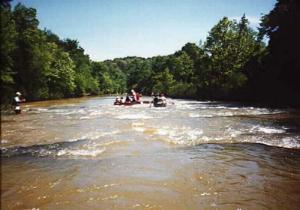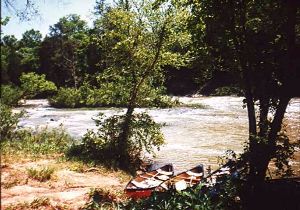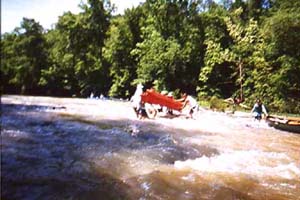by Doris White

It was exciting to see flowering plants that were unknown to science. At least eight new species of plants were growing in an open glade along the banks of the Little Cahaba River near West Blockton in Central Alabama.
The Nature Conservancy (TNC) of Alabama was host to this “Partnership in Conservation” river trip and visit to the Bibb County Glades. Wendy Allen, TNC Director, invited representatives from industry, federal and State government, business, environmental agencies, academics, and the conservation community to visit the glades and to share in the excitement of scientific discovery. Judson College was represented by Dr. Thomas Wilson and daughter Caroline, Anne Walton Garrison, Clark Wheeler, Stacy Sloan, the author, and Marion residents Kay and Allison Beckett. We gathered at Limestone Park on the Little Cahaba River and were welcomed by Charles Turner, owner of the park.
Wendy Allen, when asked what she liked about the canoe trip, said, “Getting people out to learn about the river and enjoy it.” Mr. Tom Follarth, Georgia Game and Fish Division, said that “the partnership formed between Bibb County and TNC to protect the glades is a good example of local government and a non-profit organization working together to protect the environment.”
Dr. Randal Haddock, Field Director of the Cahaba River Society, pointed out that there was also rare aquatic life in the river. The Orange-nacre Mucket, a threatened mother of pearl mussel, is found in the Little Cahaba River. Dr. Haddock displayed a specimen of this mussel and discussed its biology. This mucket disperses her young in a bizarre way. She forms a sticky tube protruding up to eight feet from her body. Her larvae are crowded in the end of this long tube and their wiggling attracts a fish which bites the tip of the tube and gets a mouth full of parasitic mucket larvae.
Dr. Doug Jones, retired Director of the University of Alabama’s Natural History Museum, geologist, and Chairman of TNC Board, gave us a lesson about the geology of the river environment. The glades were formed about 500 million years ago during the continental drift of the Pangea period. The continental plates pushed land up and formed the Appalachian Mountains. At the base of the mountains are the glades and shoals which contain large amounts of dolomite and quartz chert The water running from the Appalachian Mountains down to the Gulf carved the rock and shaped the land. In the process of breaking down the softer rock, it formed the shoals and rock outcroppings along the river.
Dr. Jones said that TNC goal is to “protect the habitat of threatened and endangered species of plants and animals.” TNC determines what species are important according to scientific priorities. When a valuable resource is identified, TNC develops a plan for the land and then makes every effort to protect the area.

The Kimberly-Clark Company gave the glades to TNC. Many businesses, when they discover ecosystems worthy of protection make efforts to protect the resource by working with environmental organizations such as TNC.
Canoeing the Little Cahaba River was great fun but the real attraction was a visit to the unusual glades ecosystem. Jim Allison, botanist for the Georgia State Museum of Natural History, discovered the Bibb County Glades and quickly recognized at least eight species of plants that were unknown to science. After a fine lunch, Mr. Allison lead us to one of the glades and told the story about his discovery of the glades and about the natural history of the area.
Mr. Allison was hired by TNC to inventory plant species in areas such as the Little Cahaba River. Allison was aware of the unusual conditions of glades and he was quick to locate several glades along the river.
Mr. Allison explained why the glades along the Little Cahaba River were unusual and why they have existed for thousands of years. The near pure dolomite parent geologic material has a high percentage of magnesium and calcium making the soil very alkaline. The soil is shallow over the large rocks and the habitat allows for the growth of grasses and small drought-tolerant flowering plants. The presence of longleaf pines revealed the role of fire in maintaining the open character of the glades.
It was interesting to hear Mr. Allison tell about each unnamed plant species with descriptive names such as the Yellow Cahaba Paint Brush, Morris Barber Button, Lesser White Top Sage, Glade Beard Tongue, Prairie Gromwell, the Sticky Rosin Weed, and the Cahaba Prairie Clove.
Mr. Chris Oberhulter, a botanist in TNC, said that they are going to experiment with fire ecology in the glades. In previous investigations, it was discovered that natural fires had occurred in the glades. The extent to which fire helped with the reproduction of the plants was not certain.

We studied the plants along the side of the river. One shady bluff was covered with giant Mountain Laurel plants in full bloom. Colonies of flowering Cahaba Lilies made the river beautiful and reminded all of us of our duty to protect valuable resources such as this small river and the glades. We saw turtles, snakes, a family of Wood Ducks, and numerous songbirds.
We came back a little sore, wet, scratched up and somewhat bruised. However, we all enjoyed the trip. We look forward to our next adventure in the great Alabama outdoors.